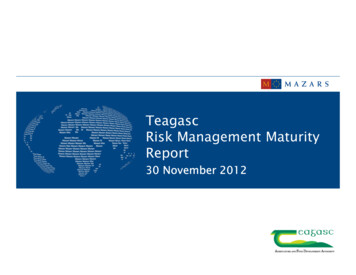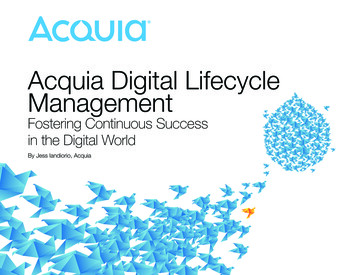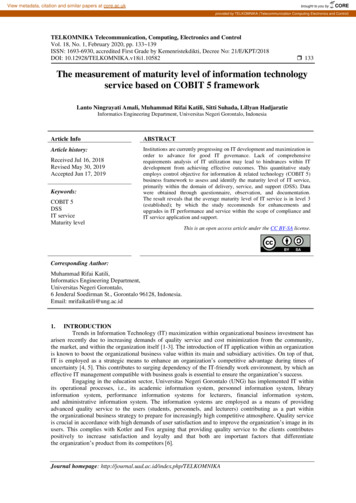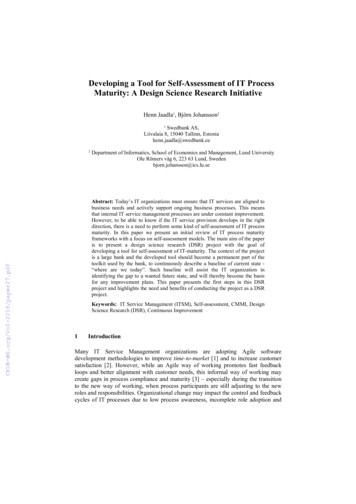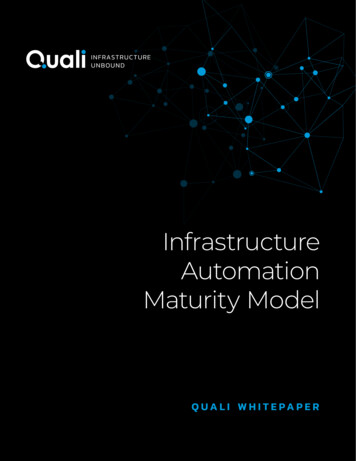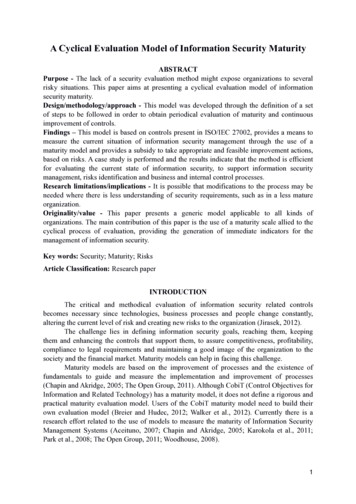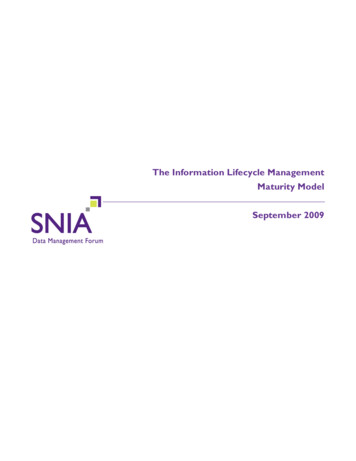
Transcription
The Information Lifecycle ManagementMaturity ModelSeptember 2009
The Information Lifecycle Management Maturity ModelProduced By:Bob RogersChair of the Data Management Forum’s ILM Initiative, andCTO, Application MatrixPaul FieldData Management Forum Board Member and Independent ConsultantTerry YoshiiStorage Architect, Intel and Project LeadContributors (in Alphabetic Order):NameRoleCompanyDale DuckwitzEnd UserHanover Insurance GroupMikhail GloukhovtsevEnd UserCSCShawn PartridgeEnd UserRockford ConstructionJackson SheaEnd UserRegency GroupMark SobatkaEnd UserUS BankEdgar St PierreDMF/ILMIEMCKurt WongEnd UserVISAAdam YangEnd UserTD BankCopyright 2009 SNIAAll rights reserved. All material in this publication is, unless otherwise noted, the property of theSNIA. Reproduction of the content, in whole or in part, by any means, without proper attributiongiven to the publisher, is a violation of copyright law. This publication may contain opinions of theSNIA, which are subject to change over time. The SNIA logo and the Data Management Forum(DMF) logo are trademarks of the SNIA. All other trademarks are the property of their respectiveorganizations.ii 2009 STORAGE NETWORKING INDUSTRY ASSOCIATION
The Information Lifecycle Management Maturity ModelTable of ContentsExecutive Summary. 2What is a Maturity Model? . 3Introducing Information Lifecycle Management . 3ILM 2.0.5Total Cost of Ownership .7ILM Maturity Model Overview. 7How Do You Use the ILM Maturity Model. 7Major Assessment Areas of the Model .8Business Integration . 8Application and Information Alignment.8Data Management. 8Infrastructure and Service Management.9Conducting Interviews and Scoring the Maturity Model. 9Maturity Model Checklist .10ILM Maturity Model Details . 12Measuring Business Integration .12Measuring Application and Information Alignment.15Measuring Data Management.17Measuring Infrastructure and Service Management.21Infrastructure and Service Management Definitions.22ILM Service.23ILM Maturity Model Usage Examples . 24Recommendations . 28Call to Action .28About the DMF. 29iii 2009 STORAGE NETWORKING INDUSTRY ASSOCIATION
The Information Lifecycle Management Maturity ModelList of FiguresFigure 1. The Four Stages of Growth .3Figure 2. Service Management for Information Management .4Figure 3. ILM 2.0 - The Next Phase.6Figure 4. Measurement Area Descriptions.9Figure 5. Checklist for Using the Maturity Model. 11Figure 6. Measuring Business Integration . 13Figure 7. Business Integration Definitions. 14Figure 8. Measuring Application and Information Alignment . 15Figure 9. Application and Information Alignment Definitions . 16Figure 10. Measuring Data Management . 18Figure 11. Data Management Definitions . 20Figure 12. Measuring Infrastructure and Service Management . 21Figure 13. Infrastructure and Service Management Definitions . 23Figure 14. ILM Service . 23Figure 15. Sample Maturity Model Results Summary . 26Figure 16. Maturity Model Dashboard. 27iv 2009 STORAGE NETWORKING INDUSTRY ASSOCIATION
ILM Maturity ModelExecutive SummaryThe Data Management Forum’s Information Lifecycle Management Initiative (ILMI) and the SNIA EndUser Council (EUC) began a joint effort in early 2008 to develop an Information Lifecycle Management(ILM) Maturity Model. The work was patterned after the Capability Maturity Model Integration1(CMMI) from the Software Engineering Institute at Carnegie Mellon University. The ILM MaturityModel provides a standardized tool for consistent point-in-time assessment of the maturity of ILMcapabilities within an organization. There were three objectives for this work effort: Provide a standardized tool that would assist organizations determine where they stand relativeto best practices in managing their information. Help organizations improve their ILM practices to balance their information technology servicelevels and therefore lower costs. Help organizations to set priorities on IT investments, by aligning their costs with the changingvalue of their information over time.Information Lifecycle Management is not a product conveniently packaged and delivered in a box.Consider ILM as an ongoing process and as a service management strategy. The Storage NetworkingIndustry Association (SNIA) defines ILM as:“The policies, processes, practices, services and tools used to align the business value ofinformation with the most appropriate and cost-effective infrastructure from the timeinformation is created through its final disposition. Information is aligned with businessrequirements through management policies and service levels associated withapplications, metadata and data.”Notice that the SNIA definition of ILM does not mention the word “storage.” Information is the assetto be conserved and protected; storage represents one of the resources that enables ILM, but it is byno means the only resource that is important to the efficient management of information over time.Another common question is how ILM relates to the Information Technology Infrastructure Library(ITIL)2. ITIL is an internationally recognized set of best practices that focus on service management.ILM extends and refines ITIL concepts regarding information management. SNIA strongly recommendsthat an ILM project begin with a service management strategy based on ITIL, the Control Objectivesfor Information and related Technology (COBIT)3, or any one of several other service managementframeworks. All of these frameworks begin with an assessment of the business process which is afundamental step in the information management process. This is where the ILM Maturity Model .org/Template.cfm?Section COBIT6&Template /TaggedPage/TaggedPageDisplay.cfm&TPLID 55&ContentID 3151922 of 292009 STORAGE NETWORKING INDUSTRY ASSOCIATION
ILM Maturity ModelWhat is a Maturity Model?The concept of a maturity model dates back to the early ‘70’s when Cyrus F. Gibson and Richard L.Nolan, wrote about the four stages of growth in the Harvard Business Review4.Figure 1 below shows the four stages defined by Gibson and Nolan.Although Nolan’s work pre-dated the CMMI model developed by Carnegie Mellon by many years, it isthe Carnegie Mellon Software Engineering Institute’s CMMI that most people think of when they thinkof a Maturity Model. The basic concept is the same; it is an appraisal process that can be used toestablish a baseline, set performance goals, measure progress, and evaluate the effectiveness oforganizational processes. The CMMI has succeeded because it provides a model framework, and awidely used appraisal process that can be applied to software development projects (its original use),and other organizational processes. More information about the CMMI, can be found egrationIT is introduced and end-users have a « hands-off » approach to systems andapplications. IT tends to be viewed as a mysterious group who are difficult tocommunicate with but nevertheless provide critical services.IT services proliferate and consume increasingly larger proportions of corporate anddepartmental budgets. This stage is frequently marked by organizations rebelling againstcentralized IT and building their own applications and systems often without regard forplanning and control.As the cost of IT increases and becomes more apparent, Controls start to be appliedand IT begins to shift from managing computers to managing data resources.As controls are applied and discipline is established, more economic efficiency isachieved by justifying expenditures and eliminating duplication.Figure 1. The Four Stages of GrowthIntroducing Information Lifecycle ManagementILM is not a piece of hardware or software. Furthermore, ILM is not unique to storage. As statedpreviously, the word “storage” does not appear anywhere in the SNIA definition. Information lifecyclemanagement is a service management practice applied to information.The reason SNIA focuses so much effort on Information lifecycle management is that informationneeds to be managed, preserved, and maintained. The storage industry is well positioned to makesure that information is managed correctly and that digital information doesn’t die a premature death.4Managing the Four Stages of EDP Growth; Cyrus F. Gibson and Richard L. Nolan; Harvard Business Review; January–February 19743 of 292009 STORAGE NETWORKING INDUSTRY ASSOCIATION
ILM Maturity ModelILM represents a holistic approach to information management: so that five years; ten years; or,whatever number of years from now information continues to be usable. That is just one example oflooking at the information lifecycle; there is also the need to understand data protection needs, interms of recovery time and recovery point objectives. The collaboration process is critical todiscovering the services needed by information assets.Information Lifecycle Management depends on a service management strategy to be meaningful asshown by Figure 2. In the middle layer of Figure 2 are service management policies and service levelagreements. Think of it as what information deserves to be preserved (including all the accompanyingservices accorded critical information), and what information should be used and immediatelydiscarded? Without a set of service management policies and objectives everything has to be managedthe same way and that generally translates to “retain everything.” That is the issue in many datacenters. Without the initial step of collaborating with the business process owners, and otherstakeholders in the information management process, there is no way to know and understand thevalue of the information, what the needs are, or how it should be managed over time. An ILM strategybegins with the process of working with all of the stakeholders.Stakeholder identification can be especially challenging when the appointed project manager is aStorage or System Administrator that inherited the job of implementing an ILM program. Technical ITstaff people are accustomed to solving technical issues but not necessarily business issues. Anexecutive champion (i.e., somebody fairly highly placed in the organization) can help guide the process,and has the visibility of all the potential users of the affected information. This collaboration willprobably be enlightening for everyone involved. Frequently the various people who are participants inFigure 2. Service Management for Information4 of 292009 STORAGE NETWORKING INDUSTRY ASSOCIATIONManagement
ILM Maturity Modelthis process use the same set of words to mean entirely different things. Developing a commonterminology surrounding information management is important. In addition, although Service LevelAgreements (SLAs) probably exist, it is uncommon for such SLA’s to include specifics about howinformation should be managed. This is often a learning experience for everyone involved.Finally, once the service management policies and procedures have been developed, things start to getmuch easier. Information classification becomes a (relatively) simple process of applying rules toinformation objects for data and content management.ILM 2.0When SNIA introduced the concept of Information Lifecycle Management, it was embraced by manyonly to find that implementation was extraordinarily challenging. Few tools existed, and the processesand procedures needed to interpret the service requirements of information assets were not widelyavailable. The developments of new technologies and social pressures (e.g., eDiscovery and globalwarming) have accelerated the impetus to apply service management techniques to information. Theprocesses and procedures associated with ILM have been created or adapted from other relateddisciplines as exemplified by this Maturity Model.ILM 2.0 re-introduces the concept of Information Lifecycle Management with accompanying processesand procedures absent from earlier days. Make no mistake; Information Lifecycle Management is still adifficult and challenging proposition, but enough companies have had sufficient experience to relatehow to accomplish that objective.Figure 3 illustrates the comprehensive and cohesive nature of information lifecycle management.Information strategy, architecture, and governance feed into the information management process. Forexample, the Legal department and others need to be able to find information quickly without slowingdown or stopping the whole organization. In other words, there are many different objectives interms of enterprise information management, and it is important to be prepared to handle the job ofensuring that the information the company needs is there when and where it is needed.Figure 3 originated with another group of people who have the same goal. Take a look at “MIKE2” –“Method for Integrated Knowledge Environment.5”Information has value, and that value changes over time. Older information doesn’t always mean lowervalue either; in many places, as the age of information increases, so does the value. There is a life cyclefor everything though; some information only needs to exist for a short period of time and some hasto be retained for longer periods of time.Consider the processes that are in place today. How is the information used? Why is the informationimportant? The purpose of an ILM program is to develop an information classification scheme andapply policies so that critical information is treated to the respect and care it deserves. Preservationbegins with the creation of /What is MIKE2.05 of 292009 STORAGE NETWORKING INDUSTRY ASSOCIATION
ILM Maturity ModelInformation is everywhere nowadays. Is it important to ensure that mobile information resources aremanaged as effectively as in the glass house? In many cases the information generated by people out inthe field is even more important because it is irreplaceable. Life was so much easier when therequirement was to just provision more disk storage to store the ever-increasing about of informationbeing created, but that’s only a small fraction of what is expected today.Figure 3. ILM 2.0 - The NextPhase6 of 292009 STORAGE NETWORKING INDUSTRY ASSOCIATION
ILM Maturity ModelTotal Cost of OwnershipThe rate of decrease in the cost of managing storage has slowed due to the overwhelming complexityof managing the amount of information created today, and is beginning to increase due to externalfactors such as regulatory compliance and the barrier that complexity creates. ILM represents the bestnew opportunity to keep driving costs out.The Total Cost of Ownership (TCO) includes acquisition, environment, operations, management,service, upgrade, loss of service and residual value, usually compared over a three year period. Theannual cost of operations here is based on historical data from Strategic Research Corp and ITCentrix.In 1992 the annual cost of managing storage as originally published by Strategic Research Corp. was 5,000,000/TB. After 12 years time, in 2004, it was down to 22,000/TB or 22/GB, but the erosionrate will disappear due to overwhelming complexity unless a new approach is taken.Unfortunately concepts such as TCO don't take into account contributions to business productivity,flexibility, or competitiveness. A new metric is needed to fully express the power of ILM and itspotential positive impact on the business.ILM Maturity Model OverviewNow that ILM has been defined, the next step is to introduce the ILM maturity model. The maturitymodel fulfills two purposes:1. It defines a common framework and language for discussing ILM maturity. Then it enables arelative comparison for how far along an organization is in terms of implementing good ILMpractices. This allows an organization to see how they compare to best practices and to otherorganizations.2. It provides information to organizations about ILM best practices that allows them to improvetheir ILM implementations. In some cases it may provide a basis for an organization to start anILM implementation. This allows organizations to provide storage service levels appropriate tothe value of their information. Often this will reduce costs as organizations start to feelcomfortable with providing lower cost service levels for lower value data.How Do You Use the ILM Maturity ModelThe ILM Maturity Model is a template that includes a series of questions that can be used to develop aninterview script. Stakeholder identification is best left to the ILM implementation team. This teamshould be comprised of a multi-disciplinary group of individuals led by an executive at a level highenough to arbitrate any disputes that might arise. Stakeholders are likely to come from the ranks ofRecords Information Managers (RIM), Compliance, Legal, Security, Applications, Business Owners andothers. Conduct interviews with these stakeholders using the questions. Use separate interviewsheets for each interview and note who was interviewed. Use the answers to the questions toestablish the maturity levels.7 of 292009 STORAGE NETWORKING INDUSTRY ASSOCIATION
ILM Maturity ModelEach of the four areas of the model has key processes and a descriptive narrative to assist in thecategorization of the level of maturity. Like the CMMI, the ILM Maturity Model has five levels ofcategorization ranging from Initial or (“Ad Hoc”) to Optimizing or (“Continuous Improvement”).Establish a score for each of the four areas (Business Integration, Application and InformationAlignment, Data Management, Infrastructure). The score for each area will be the lowest level asdetermined by the answers to the questions. Consolidate the area scores on a final scorecard for anoverall summary of ILM Maturity Levels.Major Assessment Areas of the ModelBusiness IntegrationThe business integration portion of the Maturity Model focuses on the policies, and processes of thebusiness, as well as governance, business process value, and requirements. ILM practices need to beintegrated with how the organization conducts its business. This implies that the knowledge of howthe business is run is a key part of an ILM strategy. The initial level depicts a reactive (not pro-active)environment in which the ILM team, if it exists, is unaware of business and data governance policies, orof the linkage to business process value.Application and Information AlignmentThe alignment of applications and information moves the analysis of policies, processes, governance,and value deeper into IT by studying the ownership of information, the duplication and dissemination ofinformation, and data models. ILM practices need to be aligned with the organization’s applications andinformation. This implies an understanding of an organization’s applications and information. Servicequality, security, and data protection all factor into how well applications and information are aligned.Data ManagementThe data management section continues to delve into the management techniques of the organization.The creation and maintenance of metadata appears at this stage of the model. Metadata is the basis forILM decision-making. At the initial stage, there is no concerted retention of metadata, and at theopposite end (Optimizing) metadata are automatically maintained as the environment changes andmatures. ILM policies need to be incorporated in an organization’s data management practices. Thisties the desired service levels to actual service level implementations.Data management processes build on the metadata inventory to define a continuum ranging fromanecdotal knowledge data and location to fully automated policy-based management.Metrics introduce the concept of key performance indicators (KPIs) that lead to a common taxonomyand automated reporting of data quality.8 of 292009 STORAGE NETWORKING INDUSTRY ASSOCIATION
ILM Maturity ModelInfrastructure and Service ManagementThe final category of infrastructure and service management focuses on criteria such as dataprotection, connectivity, security, and data migration. ILM policies need to be reflected in the actual ITinfrastructure. There should be higher cost infrastructure that supports the higher service levels, andlower cost infrastructure that supports the lower service levels. And there should be mechanisms inplace, manual or automated, that move data between service levels at the appropriate time.Figure 4. Measurement Area DescriptionsConducting Interviews and Scoring the Maturity ModelThe area covered by the Maturity Model is very broad. An iterative approach (probably beginning withthe critical business processes) can yield valuable service management information and prepare theassessment team for the other focus areas in the Maturity Model. Regardless of the starting point, itis important to study the focus areas to identify target areas of opportunity. It would be very unusualfor any of the areas not to be represented by one or more stakeholders whose responsibility is tomanage that area. Sometimes it may be difficult to identify the individual or even the role, so buildinga network of relationships can be very useful.Once the target areas, roles, responsibilities, and individuals are identified the next step would be totailor a set of interview questions. A common difficulty (and one to anticipate) is that the terminologymay not be understood (or worse misinterpreted) by the people targeted for interviews. SNIA’s DataManagement Forum has been working to alleviate this issue and recently published “Building a9 of 292009 STORAGE NETWORKING INDUSTRY ASSOCIATION
ILM Maturity ModelTerminology Bridge Guidelines for Digital Information Retention and Preservation Practices in the Datacenter6”which describes many frequently used terms and how their meaning changes depending on the role ofthe individual. The “Terminology Bridge” was two years in the making and has sparked several activediscussions with SNIA. There are many different interviewing techniques (e.g., individually, or as a rolebased group). It is a good idea to retain a set of records of each interview to review comments,understand context, or obtain more information during follow-up conversations regardless of how theinterviews are conducted,Scoring the focus area is the hardest part of using the Maturity Model. It requires some subjectiveevaluation of each of the areas despite efforts to offer objective criteria. Don’t be overly concernedabout scoring; the Maturity Model is intended to be a learning tool and it is not a “pass/fail” exercise.There are a variety of ways to handle scoring; some users have broken the results into “structured”and “unstructured” categories. Others have broken the results into “open systems” and “mainframe.”There are likely to be many other equally valid ways of summarizing and scoring the Maturity Modelresults.During the development of the Maturity Model and discussions of how to score the results, theconsensus of opinion was that to maximize the value of the exercise, the lowest (or “weakest”) ratingin an area should be representative of that whole area. For example, if several interviews producedvery high ratings in an area but just one interview suggested a much weaker or less developedstructure, then the lowest would be the one used for scoring purposes.It has been said many times already that there is no one right answer. To elaborate on that statement,there is no one spot in the Maturity Model that is right for every company. What the Maturity Modeldoes is point to places where additional investments might be appropriate.Maturity Model ChecklistFigure 5 is an example of a Maturity Model Checklist. Having a thorough understanding of theproject’s objectives is the first, and probably the most important item on the list. For example,expense reduction and litigation preparedness are frequently listed as objectives. Be prepared forconflicting objectives (e.g., litigation preparedness may initially increase expenses by preservinginformation for longer periods of time). Having a well documented set of objectives with executiveapproval is likely to expedite the assessment process.Secondly, determine how much time will be spent on the assessment process and who in theorganization might have similar priorities. During Maturity Model discussions, several participantsmentioned having spent large amounts of time locating documents and even the right set ofstakeholders. Furthermore, there was a significant amount of preparation time required for each6You can obtain a copy of “Building a Terminology Bridge” from the DMF website athttp://www.snia.org/forums/dmf/knowledge/term bridge/ and you can participate in active discussion about it and otherData Management topics at the DMF Community site, http://community.snia-dmf.org.10 of 292009 STORAGE NETWORKING INDUSTRY ASSOCIATION
ILM Maturity Modelinterview to ensure that the terminology fit the stakeholder’s normal vocabulary. IT-relatedterminology was not commonly understood by individuals outside the Data Center.The checklist is an example, some changes may be necessary to fit specific organizational needs. Atthis point, it is critical to identify the correct stakeholders to 7.18.19.20.21.Identify goals/objectives in doing the ILM AssessmentIdentify the amount of time you are willing to invest in performing the ILM assessmentIdentify primary stakeholders (and alternates) examples below:a. Functional Managers (RIM, Legal, Compliance, HR, Security, etc
ILM Maturity Model 3 of 29 2009 STORAGE NETWORKING INDUSTRY ASSOCIATION What is a Maturity Model? The concept of a maturity model dates back to the early '70's when Cyrus F. Gibson and Richard L. Nolan, wrote about the four stages of growth in the Harvard Business Review4. Figure 1 below shows the four stages defined by Gibson and Nolan.


